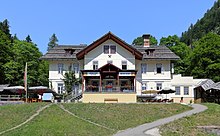Salt worlds
Salzwelten is a collective term created for tourism reasons in 2005 for three salt mines in Austria that are accessible as show mines . One each is located in the Hallein district of Bad Dürrnberg (Salzburg), in Hallstatt (Upper Austria) and in Altaussee (Styria).
Hallein Salt Mine
The show mine is located in the Tennengau district capital Hallein and was previously known as the Hallein salt mine . The new name was chosen to identify the location of the mine in the province of Salzburg and its importance for the city of Salzburg.
In the Hallein mine, salt was mined by the Celts around 2500 years ago . Thanks to the large salt deposits in the Dürrnberg, Prince Archbishop Wolf Dietrich von Raitenau was able to contribute to the expansion of the baroque residence city of Salzburg with the rich income. Special features in this mine are two long miners' slides, a ride on the mine train , an underground raft ride on a salt lake and as "Celtic Village" designated, small open-air museum for days .
Hallstatt Salt Mine
The main attractions of the Hallstatt Salt World are a 64 m long miner's slide, which is considered the longest in Europe, seven very large salt crystals in the salt crystal chamber and an underground salt lake. From 2015, a wooden staircase found during mining archaeological investigations in the Salzberg will also be on display. The staircase, which was used by prehistoric miners in the salt mountain 3500 years ago, is the oldest surviving wooden staircase on the European continent. The central theme of the Hallstatt Salt Mine is prehistoric mining, for which the discovery of the corpse of a miner from the Latène period in the mountain in 1734 serves as a hook. This "man in the salt" is believed to have been around 350 BC. In a disaster in the mine. Above-ground finds from the Salzberg and the valley, such as stone axes and deer antler picks, suggest that salt has been produced in Hallstatt for over 7,000 years.
The mining archaeological investigations in the Salzberg, which have been carried out since the 1960s by scientists from the Natural History Museum in Vienna in cooperation with Salinen Austria AG and since 2013 also Salzwelten GmbH, enabled underground mining from around 1500 BC. Prove. So far there is no older evidence of a salt mine anywhere in the world. Since the mining technology determined from the oldest known evidence is already fully developed, the beginnings of salt production in Hallstatt should, in the opinion of the researchers involved, date much earlier. In the Hallstatt Salt Mine, in addition to the traces of prehistoric mining, there are also recreated scenes that explain the different mining techniques during the various epochs.
Altaussee Salt Mine
Salt is still mined in the Altaussee Salt Mine. This mine in the far north-west of Styria is the largest salt deposit in Austria. During the Second World War , 7000 works of art, mostly from Austrian and German museums, were stored here. In the last days of the war, the Linz Gauleiter ordered the mine to be blown up in order to destroy the art treasures. Eight camouflaged aerial bombs were brought into the interior of the pit. However, the project was prevented by attentive miners. Well-known stored paintings included the Ghent Altarpiece and well-known paintings such as the Sistine Madonna by Raphael , the Tower of Babel by Pieter Brueghel and the Lady with Ermine by Leonardo da Vinci . The Barbara chapel with an altar made of pure salt stones is worth seeing in this mine . Special features here are also two miners' slides and an underground floating stage where an effective light show is presented. Since 2010, the Altaussee mine has also been home to the Kunst am Steinberg exhibition series , which offers up to five artists a forum for their art in annual group exhibitions.
Web links
- salzwelten.at: Website of the tourism company
Individual evidence
- ↑ Oral information from H. Pucher, Salzwelten GmbH, March 2014.
- ↑ Oral information from H. Reschreiter, excavation manager Hallstatt mine, Natural History Museum Vienna, Prehistoric Department, in March 2014
- ↑ Salt Mines Altaussee: Art on the Steinberg. Retrieved April 13, 2014 .



